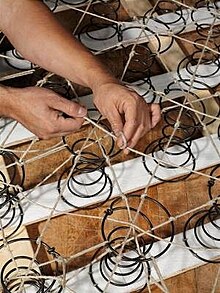Box-spring
This article needs additional citations for verification. (March 2013) |


A box-spring (or divan in some countries) is a type of bed base typically consisting of a sturdy wooden frame covered in cloth and containing springs. Usually the box-spring is placed on top of a wooden or metal bedframe that sits on the floor and acts as a brace, except in the UK where the divan is more often fitted with small castors. The box-spring is usually the same size as the much softer mattress that is placed on it. Working together, the box-spring and mattress (with optional bed frame) make up a bed. It is common to find a box-spring and mattress being used together without the support of a frame underneath, the box spring being mounted directly on casters standing on the floor.
The purpose of the box-spring is threefold:
- to raise the mattress's height, making it easier to get in and out of bed;
- to absorb shock and reduce wear to the mattress; and
- to create a flat and firm structure for the mattress to lie upon.
The first rectangular spring-cushioned wire frames to support mattresses did not have wood rims or cloth covers. These were called bedsprings. More and more box-springs are being made out of wood, then covered in fabrics. Wood makes a better support system for the newer memory foam and latex mattresses.[citation needed] The newest design in box-springs is the folding box spring made of wood or metal, then covered in fabric which can fold in half and can be sent by shipping and courier companies.[1]
With the increasing height of mattresses, manufacturers now make box springs in different heights. Standard "high profile" box springs are 9 inches (23 cm) in height, whereas "low profile" box springs are between 5 and 5.5 inches (13 and 14 cm). The difference between the two heights is purely aesthetic and makes no difference in the support provided for the mattress.
Alternatives
Box-spring beds are especially popular in the United States, Canada and Australia.
Alternatively, in Japan, futon mattresses are usually either placed on a bedframe or on the floor, without the use of springs.
In Europe, wooden frames with a middle section consisting of springs held in place by wire (to be put into the wooden bedframe as a unit) used to be the standard for most of the 20th century.
The springs have mostly been replaced by pre-bent wooden slats (usually glulam made from beech or birch) which are joined to the outer wooden frame by some form of flexible rubber bolt, shoe or socket. This lath floor provides suspension, allows the mattress to ventilate, and can be designed to be vertically adjustable in order to elevate the legs and / or the torso.
A more simple approach is to join straight laths with a textile strap so that they can be rolled up for transport and placed right into the bedframe.
References
- ^ "Invention Machine and the Case of the Boxed-Up Box Spring". Xconomy. Retrieved 14 June 2015.
